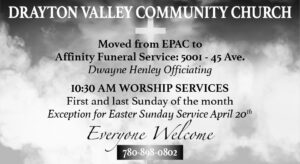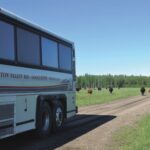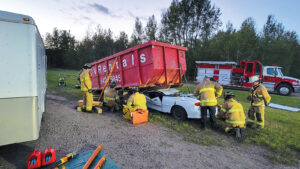During the summer of 2021, Brazeau County completed the installation of a new solar system at the Violet Grove Lagoon.
The 64 solar panels generate enough power to run the aeration system for the innovative Constructed Floating Wetlands over the lagoon, and supply power to the transfer station. This new system is in addition to over 900 solar panels installed in 2016/17 at the Breton Fire Hall, Lodgepole Fire Hall, the Rocky Rapids Water Treatment Plant, and the County Administration building.
Dr. Chris Birchall Dentistry
Dr. Birchall Dentistry in Drayton Valley, Alberta. A dentist in Drayton Valley, Alberta.

Drayton Valley Insurance
Share on facebook Facebook Share on email Email Share on linkedin LinkedIn Share on whatsapp

Drayton Valley Community Church
DV Community Church. Located at Affinity Funeral Services, officiated by Dwayne Henley.

All Saints Anglican Church
Drayton Valley, All Saints Anglican Church participates in the Anglican Liturgy, which comforts and sustains us. Many have said that in such a busy and changing world it is important to come to a place that feels like home.

Valley Gallery and Framing
Share on facebook Facebook Share on email Email Share on linkedin LinkedIn Share on whatsapp
“Brazeau County is taking action to protect our environment and air,” says Reeve Bart Guyon. “Combined, these projects will offset almost 150 tonnes of greenhouse gas emissions annually, which helps reduce the County’s carbon footprint.”
The five solar systems together generate almost 298,800-kilowatt hours each year, with about 34,100-kilowatt hours/year expected from the new Violet Grove solar system. Funding for the project will come in part from Municipal Climate Change Action Centre’s (MCCAC) Alberta Municipal Solar Program.
As of December 20, Wild Rose School Division will be laying off 46 Educational Assistants due to the division not receiving the Jordan’s Principle grant from the Federal Government.
Grant delay impact education assistant funding
Brad Volkman, the superintendent for WRSD, says in the past the funding has come through quickly and without any issues. The grant money is to be used to provide support and services to indigenous youth in the school division.
“Historically, these grants have been approved at the regional level, enabling us to offer critical services without interruption. Based on this expectation, we hired several additional Educational Assistants for the start of the 2024–2025 school year for the purpose of providing support to eligible First Nations students,” says a press release from WRSD.
Human rights tribunal couldn’t meet time demands
However, the Federal Government is currently backlogged when it comes to the grant. A Human Rights Tribunal was held to look into the funding, as it is supposed to be issued quickly as some requests for funds are urgent. They have since ordered the government to take action.
On December 10, 2024, Indigenous Services Canada responded in a report that it was not possible for them to meet the demands of the Tribunal.
Because there is no answer as to when the funding might come through, WRSD had to make the decision for layoffs as they had not budgeted for the positions outside of the grant.
The policy within WRSD is that when layoffs occur, those who are on probationary status, which is 120 days, are the first to be let go. There were 35 part-time and full-time EAs let go because of this policy. However, not all of them worked with Jordan’s Principle students.
One non-probationary EA was laid off, and the remaining ten were voluntary lay-offs, says Volkman.
“What happens is the probationary ones, due to collective agreement requirements, are laid off first, but then we can offer more tenured EAs those positions,” says Volkman.
He says the voluntary lay-offs were EAs working with Jordan’s Principle students who were offered positions with students who have more complex needs. Volkman says they declined the positions and had to be laid off.
“It’s not easy for them because in some cases the job they were offered would have been less hours or [perhaps] they would have been in a location that required them to drive a further distance,” says Volkman.
There are still 95 full-time EAs in the inclusive education department.
Drayton Valley Ski Hill Closes After 60 Years | Challenges with Weather, Insurance, and Volunteers
After 60 years of operation in the community, the Drayton Valley ski hill has closed its doors.
Weather, Insurance and Volunteers an issue
Randy Beckett, the president of the Drayton Valley Brazeau Snow Club, says there were three main factors that went into the decision to shut down: weather, insurance, and lack of volunteers.
The ski hill was built by volunteers and has been running with volunteers since then. Funding was partially provided by grants, fundraising, and rental and usage fees for the hill. These funds went toward bills like insurance and electricity. They were also used for the maintenance of the ski hill and the equipment. None of the volunteers were paid for their time.
When Beckett stepped into the role of president about eight years ago, the club was in debt and the equipment was in need of repair. A government grant of $17,000 and a massive fundraiser in the community gave them enough money to fix things up.
To round out their services, Beckett says they began to offer tubing. The club recognized that not everyone wanted to ski or were able to ski. Tubing was available to everyone and was less hard on the body. Each of the tubes was sponsored by a company, with the funds going toward the maintenance of the hill.
However, the lack of snow over the past few seasons has meant less use of the ski hill, and therefore less funds coming in.
“Unfortunately, Mother Nature has not been kind to us,” says Beckett.
In 2023, much of the local area didn’t have snow for Christmas. Beckett says the ski hill didn’t even open in the 2023/24 season.
“In my seven or eight years, we only opened three years because of snow,” says Beckett.
Insurance companies stepping away from offering coverage to ski hills
Then there was the issue with insurance. After a court case in B.C. where a customer sued a ski resort, many insurance companies stepped away from offering insurance to ski hills. Beckett says there are now only three underwriters in the world who will consider insuring a ski hill.
“Eleven of us little hills got our insurance canceled [a couple of] years ago,” says Beckett.
Previously, the Rural Municipalities of Alberta covered the insurance of the ski hill. When the insurance was cancelled through RMA, they had to find a new underwriter. The bill for the season was $24,000.
“Our insurance was $24,000 last year and we didn’t open,” says Beckett.
Finding volunteers to work the ski hill has also been a challenge.
“Everybody has so many different directions to go now in their lives,” he says. “They have just about everything except for time.”
On average, it took ten volunteers to run the ski hill each day. Beckett and his wife had a list of about 80 volunteers they could call on. However, there were times when they called all of those people and none of them were available to fill a shift for someone who had to cancel.
All three of those factors were at play when Beckett received a call from the insurance company in preparation for this season. They needed Beckett to go through everything on the property again, as they felt much of the equipment and the chalet were undervalued.
Beckett explained to them that it didn’t matter what the replacement value was for the chalet or the lift. If they failed or burned down, Beckett says the club would have to close.
With that in mind, he had put in a lower value for the chalet and other items as they would never be using the insurance to replace them. That was the only way they would be able to afford to run the ski hill. The insurance company explained that if he didn’t cover it for at least 90 percent of the replacement value they would get nothing.
“I said take the insurance off of it, I’ll take the risk,” he says.
Then the insurance company started going into details about the rental equipment, and how all of the people renting the bindings and skis had to be trained by the manufacturers in how to use them.
“What the real issue is, when it comes to insurance companies, is they do not like volunteer organizations in any way,” says Beckett. “Every one of these 11 hills that got their insurance cancelled, I believe, were volunteer organizations.”
Beckett says they feel that the volunteer organizations are unstable, as the volunteers can change regularly and with little notice.
The rental items for the ski hill will be auctioned off by Team Auctions on their December 7 sale. The property will be sold in the new year.
The Free Press asks – “What are your fondest memories of the Drayton Valley Ski Hill?”
“This fills me with nostalgia and gratitude! I started skiing at this hill at just two years old, and it ignited my love for skiing. My parents nurtured my passion by enrolling me in a ski program, and I spent countless weekends racing and growing. Our hill may not have been the biggest, but it was a place we were able to be kids at while not playing hockey or ringette. My dad and papa selflessly served as ski patrols for years, and we reveled in every moment we spent there. My papa’s dedication to the hill was remarkable as he had welded so many pieces there making it the hill it was today, and I’m deeply thankful for the volunteers who helped shape it into the haven it became. All three of my boys learned to ski on this hill, and I’m forever grateful for the escape and liberation it brought us.” – Leslie Anne Fraizer
“I learned to ski on the hill, my kids learned to ski on the hill. We’ve had many get-togethers on the hill with family and friends. As a volunteer I got to see so many littles learn to ski/snowboard and then advance to be on their own then onto the T-bar. They all get excited when they get to go on the big hill. I’ve spent many hours volunteering there as I was on the board for 20+ years and even when my kids weren’t skiing I was there.It was a great hill for many to learn on, it was in our backyard. When we decided to make the tube part it brought more families out which was great to see. It truly will be missed as I wanted my grandkids to learn how to ski/board this year on it.” – Georgia Frost
“Ooh, so many memories of the ski hill. But I would say the best was learning to snowboard there and getting courage to do the jumps off the hills … It was always fun since it was me and my sister. We had a blast, racing down getting to the bottom and the wind burnt faces ‘cause of it.” – Tricia Cottreau
“I was on the tow rope when a porcupine decided to cross… apparently the rope had enough give to allow the people to push a big loop in it. We were able to continue up the hill and the porcupine was able to continue on its walk about” – Helen Maine
“I have so many memories there as a teen in the mid 1980s… from trying to perfect the “daffy”, “backscratchers” and the “kusak” amongst learning how to telemark. This little hill with amazing volunteers taught a ton of youth some amazing skills while maintaining a very safe and supportive environment. I am a ski patrol today because of this little hill and the “gnarly” atmosphere back in the 80s that let youth hone their skills for the mountains.” – Jon Setterlund
“Watching my son Max snowboard for the first time! And he struggled with the T-bar but never gave up!” – Kathy Schwengler
“The time I knocked myself out cold. Couldn’t stop and hit a pole. That was my last time on skis. I now snowboard. I don’t think there’s any photos of that adventure…got a free sled ride behind the skidoo!!” – Jane Marie Ellis
“When Devon broke his arm, all the other kids that broke something and the fact that we all thought we had fresh pow days” – Gord Graham
“Donna and Val Palmer encouraged me to get my Level 1 ski instructor certification and teach ski lessons at the hill. I have so many memories of teaching kids and adults basic skills for skiing. My favourite memories include the Grade 5 visits and instructing a whole class on the tow rope hill. What a great introduction for those kids- who may have never been exposed to skiing.” – Astrid Mitchell
Drayton Valley Food Bank relies on generosity
With an increase in demand for the Drayton Valley Food Bank, volunteers are concerned the facility may not keep up for much longer.
Heather and Phil Bell, the vice president and treasurer respectively, have been with the Food Bank for several years. During that time they’ve noticed a concerning trend in the uptick of users.
So far this year, they have given out hampers to 2,275 people, a stark contrast to the 2023 number of 1,653. Last year was a record year for hampers and this year has blown it out of the water.
Alberta food bank sees increased demand
The Bells says a lot of the hampers are going to families who have parents that work.
“The Food Bank, I feel, is an essential service right now, considering the need,” says Phil. “It’s something that’s heavily relied on.”
If things continue the way they have been, they’re expecting to hand out 2,556 hampers by the end of the year.
“It’s not just a blip, either,” says Phil. “This is going to continue on.”
Phil says that though they’ve seen increased usage, the generosity of the community has continued to keep up with the demand. Between food donations from local stores and food drives, the food bank has already received around $270,000 of in-kind donations.
“We have such a generous community,” says Heather. “It’s amazing.”
Heather says they are grateful for the building they’re in and the Town’s generosity in letting them use it for free. She says the location is perfect because it allows people more privacy than a location in a busier part of the community.
“But we’re outgrowing the building,” says Heather. “We’re at the point with our freezer and fridge capacity that the building can’t take anymore fridges and freezers without upgrading the electrical system.”
Space is a challenge for Drayton Valley food bank
Fridge and freezer space are vital in the Christmas season. Heather says in the past, they’ve had to turn away donations of a side of beef because they don’t have the space. Some companies have set up freezers in their buildings and offered the extra storage. Some volunteers also store some items as well.
The Bells say a sea can or some other place where they could store dried goods would be extremely helpful, as well. As it is, they have to store enough food in their building for roughly 30 hampers each pick up day.
At the beginning of November, the volunteers changed their system, and now only offer hampers on Thursdays. Phil says one recent hamper day saw volunteers hand out 86 hampers in three hours.
Creating that many food hampers also has its challenges. There isn’t a lot of room to put the hampers together and organize them, though Heather says they’ve developed a good system. Volunteers are now prebuilding hampers with dried goods for different sizes of families. On pick up days, all they have to do is go to the fridge and freezer to top the hamper off, and it can go out the door.
Thanks to a grant from the Family and Community Support Services, the Food Bank now has a part-time employee that can help with a lot of the administrative tasks. However, some recent Standards of Excellence put forth by the Federal Government is putting pressure on them as well.
The Standards of Excellence requires all Food Banks to have certain policies and procedures in place if they want to continue to be registered with Food Banks Alberta and Food Banks Canada.
Heather says it’s a great idea in theory, but the 78 page document is a massive undertaking for a busy food bank run by volunteers. Their employee is working on some of the documents, but it’s still a challenge.
“A lot of them are great ideas, but for small food banks, it’s quite overwhelming to comply with that,” says Heather.
Originally, the food banks had until March 2025 to have everything in place, but after feedback, they’ve given the smaller food banks more time to work on it.
The Bells say there are many ways for the community to help out the food bank and they won’t turn down donations if they can help it. They have more volunteers who are going through the orientation and are grateful for the continuing generosity of the community.
Drayton Valley Launches Platform to Match Volunteers with Opportunities
Community members often perform their civic duties in a variety of ways; some vote, most pay their taxes, and some volunteer their time.
The initiative, This Is Drayton Valley (TIDV), is hoping to make it easier for residents to find ways they can volunteer in their community. They’ve launched an online platform, www.lets-volunteer.com, that helps connect organizations to residents who are looking for a place to volunteer their time.
Jessica Doucette, the chair of the Healthy Community Coalition, says the idea for the platform first began when the HCC were brainstorming ways to offer programs for the clients in the Youth Hub. The biggest obstacle was finding volunteers to help out with the programs.
“We came up with this idea about creating an online platform that would make it easier for people to access volunteer opportunities,” says Doucette.
She says at that time, they were mostly considering the Youth Hub and looking for younger volunteers. They felt that an online platform would be the best way to reach out to that demographic.
When Kickstand Alberta became the parent organization of the Youth Hub, they found more challenges. As they were a newer provincial body, they weren’t ready to take on the project for all of their Youth Hubs. Doucette says rather than scrap the idea, they decided to offer it to the larger community.
“We realized it was actually an issue for everybody,” she says.
Originally, they had approached the Chamber of Commerce, who had already tried to make a similar platform. But as the HCC works under the Red Cross, they were told it wasn’t appropriate for them to work with an organization that only represented businesses. They continued to look and finally connected with Ryan Fynn, one of the founders of TIDV, to bring the idea to life.
The platform has been active for a couple of weeks, now, and as of November 22, there were 14 volunteers and 12 organizations on the site.
Fynn says the platform is similar to dating websites, in that the volunteers input information into a profile and then they can be matched with an organization that would best suit them. He says volunteers are encouraged to list things they are passionate about, their relevant skills, experience as a volunteer, how much time they want to commit, and which days they are open to help. Organizations can search for volunteers based on those parameters.
“For an example, River Valley Players is looking for a part-time musical director,” says Fynn. “If a volunteer says they are passionate about music, they will be connected to them.”
Doucette says the platform can also help people connect with someone with specific skills. “We just recently did a survey through the community parenting coalition, and we found that there’s a large majority of people that are willing to share their gifts with others,” says Doucette. “We just don’t ask the right questions.”
Fynn says it would also work well for finding volunteers for events. By listing their events and indicating what’s all involved in the positions, residents with profiles can find them and help out.
Man charged after shooting near Brazeau Dam
An Edmonton man has been charged with attempted murder after an incident that took place near the Brazeau Dam last week.
Just before midnight on Saturday November 9, the Drayton Valley RCMP received a 911 call reporting possible shots fired near the dam. As members arrived, they received an update that a female had been shot by a man with a .22 calibre rifle. The suspect, who is believed to have been part of a group who had been hunting in the area, was arrested and taken into custody without incident. Officers administered first aid to the female victim, who was suffering from multiple gunshot wounds, until emergency medical services arrived on the scene. The female victim was transported to the University of Alberta hospital where she was listed in critical but stable condition.
Leomer Serios Valencia, 43, has been charged with attempted murder, using a firearm in the commission of an offence, pointing a firearm, assault and uttering threats. After a telephone bail hearing Valencia was remanded in custody pending an appearance in Drayton Valley court.
Corb Lund plays to a packed house
Corb Lund played the Eleanor Pickup Art Centre stage for a raucous sold-out audience Thursday evening.
The Hurtin’ Albertans acoustic duo backing Lund were Grant Siemans on guitar and Sean Burns playing upright bass About a quarter of the 224 capacity seats were purchased as VIP tickets. At 5PM, the three front rows were filled as a solo Corb Lund was greeted with cheers, sat on the edge of the stage, and began singing VIP favourites, telling backstories and conversing. After the warm and friendly performance, knowing their seats were reserved, VIPs ticket holders shopped for merch in the EPAC lobby or went for a meal and refreshment to a downtown restaurant.
Several VIP super-fans commented that it was well worth the premium to be up-close and personal with Lund.
EPAC’s doors remained open as rush seating meant coming early for a preferred perch. The merch table was double-staffed as demand was high for CDs and vinyl LPs, “It’s Better with Cows Around” hoodies and Lund album cover poster three-packs. Lots of stock meant no one was disappointed. Long before the 7:30 curtain it was rare to find two seats together, however. A group of five young men just arriving before the curtain were quickly ushered to the remaining seats.
With the theatre full, an excited ambiance and the clock ticking down to showtime, it was no surprise that when the house lights dimmed, introduction completed, and Corb Lund with the Hurtin’ Albertans appeared from stage right, pandemonium reigned.
Joyful hoots and hollers, cheers, yahoos and multiple long, wavering, high-pitched vocal trilling filled the auditorium. The band, looking fresh and ready despite being midway through a long tour of Europe/US started what was only their second performance of this acoustic set.
The show opened with two songs from Lund’s 2007 Horse Soldier Horse Soldier album. The opening bars of the title track were greeted with cheers of recognition and rewarded with loud applause as was “Especially A Paint”. The set list dipped into Lund’s deep catalogue from a long career: “May you Always have Cows Around” (Cabin Fever 2012), “Devil’s Best Dress” (Losin’ Lately Gambler 2009), “Truth Comes Out” (Hair in My Eyes Like a Highland Steer 2006) and “The Cardplayers” ( El Viejo 2024).
A tribute to the late Ian Tyson included past collaborations and Tyson songs: “Someday Soon” (1964), “The Rodeo’s Over” (Hair in My Eyes…2005), and “La Primera” (Ian Tyson Lost Herd 1999). Many fan favourites peppered the performance. Prior to the intermission we were treated to “Hard on Equipment”, “This is My Prairie” , and “Big Butch Bass Bull Fiddle”. After the break, Lund introduced his next two songs as “hillbilly music” which drew cheers of anticipation. “Family Reunion” brought out the banjo and it stayed out for “Truck Got Stuck”, “Rye Whisky, Rye Whisky” and “Time to Switch to Whisky” . The audience sang backup for both. They even performed a verse and chorus “a capella” after which Lund said “buy a t-shirt, cuz we bought too many, thanks and goodnight!” But the EPAC audience was not yet ready for their good times to end. After lengthy applause, hoots and hollers, and a prolonged chant of “Corb, Corb, Corb” finally earned them their encore: a Lund solo of “S Lazy H”. It’s a plaintive ballad chronicling a family’s loss of their sixth generation ranch. The lyrics, “I have lived with the sorrow/And I will die with the shame/For now the bank owns what’s left/Of the S Lazy H” clearly tugged at the audience’s hearts. When the Hurtin’ Albertans rejoined Lund onstage, cheers banished melancholy as “Five Dollar Bill” was warmly welcomed and earned another standing ovation fitting for a memorable evening of great melody, lyrics and artistry.
I talked with Corb Lund backstage shortly after the final song and asked him how his evening was.
“It was super fun! It’s a cool little theatre. I like it!…
We were just in Europe. I think they find cowboy stuff exotic. Europeans like that about us. I know about Alberta and our regional culture, so people here pick up on the subtleties more. It’s a little different here cause people know what I’m talking about. I grew up just outside of Taber/Cardston, so I’m pretty used to small town Alberta life.”
I asked him about the set. “It’s only the second night we’ve been doing this acoustic trio, but it’s been really fun. It’s kind of different from the big loud band. I like that too, but it’s been kind of neat because there’s a lot of space to play with. Like the guys, especially Grant (lead guitar), when he’s playing his acoustic instruments there’s so much space in the theatre for it to speak. This was a blast. Thanks for having us.”
Grant Siemans has been playing with Corb Lund for 21 years. Lund gave him props explaining that any instrument he (Epiphone guitar) and Sean Burns don’t play, Grant does! I asked Siemans to expand. He listed off what he used for this acoustic trio set. “The mandolin is a Gibson F5 that’s actually Corb’s. It’s about 10 years old. It sounds awesome! The resonator is a 1931 National. I got a steal of a deal with that one because somebody painted it brown in the 1940’s. Nobody wanted it, which was awesome! It looks baaad! The banjo; Epiphone gave us. It was a new model. I asked him about the unique guitar and playing style Siemans used for most of the evening’s performance. “That’s a Manouche guitar (gypsy jazz guitar), a Djanko Rhinehart style guitar. It was made by a Winnipeg luthier named Al Beardsell, Beardsell Guitars.” The acoustic trio has no drum kit, so Siemans played manouche guitar Le Pompe style and imitates the drum kit’s cymbals, keeping rhythm and also the chording of the melody. “I like the playing, practicing, learning. It’s not work for me.”
Pleasant duty, indeed. Especially for the night’s audience!
Fast facts
- The entire solar array consists of 64 solar PV modules and has a maximum capacity of 28.8 kW DC.
- The system will produce enough electricity to aerate both lagoon cells and the transfer station for the Hamlet of Violet Grove.
- The five systems combined will generate enough electricity to power the equivalent of 25 average homes, offsetting about 150 tonnes of greenhouse gas emissions annually. Enough CO2 reduction from the environment equivalent to 3,496 new trees, and Enough to take the equivalent of 46 passenger vehicles driven for a year off the road.
As of December 20, Wild Rose School Division will be laying off 46 Educational Assistants due to the division not receiving the Jordan’s Principle grant from the Federal Government.
Grant delay impact education assistant funding
Brad Volkman, the superintendent for WRSD, says in the past the funding has come through quickly and without any issues. The grant money is to be used to provide support and services to indigenous youth in the school division.
“Historically, these grants have been approved at the regional level, enabling us to offer critical services without interruption. Based on this expectation, we hired several additional Educational Assistants for the start of the 2024–2025 school year for the purpose of providing support to eligible First Nations students,” says a press release from WRSD.
Human rights tribunal couldn’t meet time demands
However, the Federal Government is currently backlogged when it comes to the grant. A Human Rights Tribunal was held to look into the funding, as it is supposed to be issued quickly as some requests for funds are urgent. They have since ordered the government to take action.
On December 10, 2024, Indigenous Services Canada responded in a report that it was not possible for them to meet the demands of the Tribunal.
Because there is no answer as to when the funding might come through, WRSD had to make the decision for layoffs as they had not budgeted for the positions outside of the grant.
The policy within WRSD is that when layoffs occur, those who are on probationary status, which is 120 days, are the first to be let go. There were 35 part-time and full-time EAs let go because of this policy. However, not all of them worked with Jordan’s Principle students.
One non-probationary EA was laid off, and the remaining ten were voluntary lay-offs, says Volkman.
“What happens is the probationary ones, due to collective agreement requirements, are laid off first, but then we can offer more tenured EAs those positions,” says Volkman.
He says the voluntary lay-offs were EAs working with Jordan’s Principle students who were offered positions with students who have more complex needs. Volkman says they declined the positions and had to be laid off.
“It’s not easy for them because in some cases the job they were offered would have been less hours or [perhaps] they would have been in a location that required them to drive a further distance,” says Volkman.
There are still 95 full-time EAs in the inclusive education department.
After 60 years of operation in the community, the Drayton Valley ski hill has closed its doors.
Weather, Insurance and Volunteers an issue
Randy Beckett, the president of the Drayton Valley Brazeau Snow Club, says there were three main factors that went into the decision to shut down: weather, insurance, and lack of volunteers.
The ski hill was built by volunteers and has been running with volunteers since then. Funding was partially provided by grants, fundraising, and rental and usage fees for the hill. These funds went toward bills like insurance and electricity. They were also used for the maintenance of the ski hill and the equipment. None of the volunteers were paid for their time.
When Beckett stepped into the role of president about eight years ago, the club was in debt and the equipment was in need of repair. A government grant of $17,000 and a massive fundraiser in the community gave them enough money to fix things up.
To round out their services, Beckett says they began to offer tubing. The club recognized that not everyone wanted to ski or were able to ski. Tubing was available to everyone and was less hard on the body. Each of the tubes was sponsored by a company, with the funds going toward the maintenance of the hill.
However, the lack of snow over the past few seasons has meant less use of the ski hill, and therefore less funds coming in.
“Unfortunately, Mother Nature has not been kind to us,” says Beckett.
In 2023, much of the local area didn’t have snow for Christmas. Beckett says the ski hill didn’t even open in the 2023/24 season.
“In my seven or eight years, we only opened three years because of snow,” says Beckett.
Insurance companies stepping away from offering coverage to ski hills
Then there was the issue with insurance. After a court case in B.C. where a customer sued a ski resort, many insurance companies stepped away from offering insurance to ski hills. Beckett says there are now only three underwriters in the world who will consider insuring a ski hill.
“Eleven of us little hills got our insurance canceled [a couple of] years ago,” says Beckett.
Previously, the Rural Municipalities of Alberta covered the insurance of the ski hill. When the insurance was cancelled through RMA, they had to find a new underwriter. The bill for the season was $24,000.
“Our insurance was $24,000 last year and we didn’t open,” says Beckett.
Finding volunteers to work the ski hill has also been a challenge.
“Everybody has so many different directions to go now in their lives,” he says. “They have just about everything except for time.”
On average, it took ten volunteers to run the ski hill each day. Beckett and his wife had a list of about 80 volunteers they could call on. However, there were times when they called all of those people and none of them were available to fill a shift for someone who had to cancel.
All three of those factors were at play when Beckett received a call from the insurance company in preparation for this season. They needed Beckett to go through everything on the property again, as they felt much of the equipment and the chalet were undervalued.
Beckett explained to them that it didn’t matter what the replacement value was for the chalet or the lift. If they failed or burned down, Beckett says the club would have to close.
With that in mind, he had put in a lower value for the chalet and other items as they would never be using the insurance to replace them. That was the only way they would be able to afford to run the ski hill. The insurance company explained that if he didn’t cover it for at least 90 percent of the replacement value they would get nothing.
“I said take the insurance off of it, I’ll take the risk,” he says.
Then the insurance company started going into details about the rental equipment, and how all of the people renting the bindings and skis had to be trained by the manufacturers in how to use them.
“What the real issue is, when it comes to insurance companies, is they do not like volunteer organizations in any way,” says Beckett. “Every one of these 11 hills that got their insurance cancelled, I believe, were volunteer organizations.”
Beckett says they feel that the volunteer organizations are unstable, as the volunteers can change regularly and with little notice.
The rental items for the ski hill will be auctioned off by Team Auctions on their December 7 sale. The property will be sold in the new year.
The Free Press asks – “What are your fondest memories of the Drayton Valley Ski Hill?”
“This fills me with nostalgia and gratitude! I started skiing at this hill at just two years old, and it ignited my love for skiing. My parents nurtured my passion by enrolling me in a ski program, and I spent countless weekends racing and growing. Our hill may not have been the biggest, but it was a place we were able to be kids at while not playing hockey or ringette. My dad and papa selflessly served as ski patrols for years, and we reveled in every moment we spent there. My papa’s dedication to the hill was remarkable as he had welded so many pieces there making it the hill it was today, and I’m deeply thankful for the volunteers who helped shape it into the haven it became. All three of my boys learned to ski on this hill, and I’m forever grateful for the escape and liberation it brought us.” – Leslie Anne Fraizer
“I learned to ski on the hill, my kids learned to ski on the hill. We’ve had many get-togethers on the hill with family and friends. As a volunteer I got to see so many littles learn to ski/snowboard and then advance to be on their own then onto the T-bar. They all get excited when they get to go on the big hill. I’ve spent many hours volunteering there as I was on the board for 20+ years and even when my kids weren’t skiing I was there.It was a great hill for many to learn on, it was in our backyard. When we decided to make the tube part it brought more families out which was great to see. It truly will be missed as I wanted my grandkids to learn how to ski/board this year on it.” – Georgia Frost
“Ooh, so many memories of the ski hill. But I would say the best was learning to snowboard there and getting courage to do the jumps off the hills … It was always fun since it was me and my sister. We had a blast, racing down getting to the bottom and the wind burnt faces ‘cause of it.” – Tricia Cottreau
“I was on the tow rope when a porcupine decided to cross… apparently the rope had enough give to allow the people to push a big loop in it. We were able to continue up the hill and the porcupine was able to continue on its walk about” – Helen Maine
“I have so many memories there as a teen in the mid 1980s… from trying to perfect the “daffy”, “backscratchers” and the “kusak” amongst learning how to telemark. This little hill with amazing volunteers taught a ton of youth some amazing skills while maintaining a very safe and supportive environment. I am a ski patrol today because of this little hill and the “gnarly” atmosphere back in the 80s that let youth hone their skills for the mountains.” – Jon Setterlund
“Watching my son Max snowboard for the first time! And he struggled with the T-bar but never gave up!” – Kathy Schwengler
“The time I knocked myself out cold. Couldn’t stop and hit a pole. That was my last time on skis. I now snowboard. I don’t think there’s any photos of that adventure…got a free sled ride behind the skidoo!!” – Jane Marie Ellis
“When Devon broke his arm, all the other kids that broke something and the fact that we all thought we had fresh pow days” – Gord Graham
“Donna and Val Palmer encouraged me to get my Level 1 ski instructor certification and teach ski lessons at the hill. I have so many memories of teaching kids and adults basic skills for skiing. My favourite memories include the Grade 5 visits and instructing a whole class on the tow rope hill. What a great introduction for those kids- who may have never been exposed to skiing.” – Astrid Mitchell
With an increase in demand for the Drayton Valley Food Bank, volunteers are concerned the facility may not keep up for much longer.
Heather and Phil Bell, the vice president and treasurer respectively, have been with the Food Bank for several years. During that time they’ve noticed a concerning trend in the uptick of users.
So far this year, they have given out hampers to 2,275 people, a stark contrast to the 2023 number of 1,653. Last year was a record year for hampers and this year has blown it out of the water.
Alberta food bank sees increased demand
The Bells says a lot of the hampers are going to families who have parents that work.
“The Food Bank, I feel, is an essential service right now, considering the need,” says Phil. “It’s something that’s heavily relied on.”
If things continue the way they have been, they’re expecting to hand out 2,556 hampers by the end of the year.
“It’s not just a blip, either,” says Phil. “This is going to continue on.”
Phil says that though they’ve seen increased usage, the generosity of the community has continued to keep up with the demand. Between food donations from local stores and food drives, the food bank has already received around $270,000 of in-kind donations.
“We have such a generous community,” says Heather. “It’s amazing.”
Heather says they are grateful for the building they’re in and the Town’s generosity in letting them use it for free. She says the location is perfect because it allows people more privacy than a location in a busier part of the community.
“But we’re outgrowing the building,” says Heather. “We’re at the point with our freezer and fridge capacity that the building can’t take anymore fridges and freezers without upgrading the electrical system.”
Space is a challenge for Drayton Valley food bank
Fridge and freezer space are vital in the Christmas season. Heather says in the past, they’ve had to turn away donations of a side of beef because they don’t have the space. Some companies have set up freezers in their buildings and offered the extra storage. Some volunteers also store some items as well.
The Bells say a sea can or some other place where they could store dried goods would be extremely helpful, as well. As it is, they have to store enough food in their building for roughly 30 hampers each pick up day.
At the beginning of November, the volunteers changed their system, and now only offer hampers on Thursdays. Phil says one recent hamper day saw volunteers hand out 86 hampers in three hours.
Creating that many food hampers also has its challenges. There isn’t a lot of room to put the hampers together and organize them, though Heather says they’ve developed a good system. Volunteers are now prebuilding hampers with dried goods for different sizes of families. On pick up days, all they have to do is go to the fridge and freezer to top the hamper off, and it can go out the door.
Thanks to a grant from the Family and Community Support Services, the Food Bank now has a part-time employee that can help with a lot of the administrative tasks. However, some recent Standards of Excellence put forth by the Federal Government is putting pressure on them as well.
The Standards of Excellence requires all Food Banks to have certain policies and procedures in place if they want to continue to be registered with Food Banks Alberta and Food Banks Canada.
Heather says it’s a great idea in theory, but the 78 page document is a massive undertaking for a busy food bank run by volunteers. Their employee is working on some of the documents, but it’s still a challenge.
“A lot of them are great ideas, but for small food banks, it’s quite overwhelming to comply with that,” says Heather.
Originally, the food banks had until March 2025 to have everything in place, but after feedback, they’ve given the smaller food banks more time to work on it.
The Bells say there are many ways for the community to help out the food bank and they won’t turn down donations if they can help it. They have more volunteers who are going through the orientation and are grateful for the continuing generosity of the community.
Community members often perform their civic duties in a variety of ways; some vote, most pay their taxes, and some volunteer their time.
The initiative, This Is Drayton Valley (TIDV), is hoping to make it easier for residents to find ways they can volunteer in their community. They’ve launched an online platform, www.lets-volunteer.com, that helps connect organizations to residents who are looking for a place to volunteer their time.
Jessica Doucette, the chair of the Healthy Community Coalition, says the idea for the platform first began when the HCC were brainstorming ways to offer programs for the clients in the Youth Hub. The biggest obstacle was finding volunteers to help out with the programs.
“We came up with this idea about creating an online platform that would make it easier for people to access volunteer opportunities,” says Doucette.
She says at that time, they were mostly considering the Youth Hub and looking for younger volunteers. They felt that an online platform would be the best way to reach out to that demographic.
When Kickstand Alberta became the parent organization of the Youth Hub, they found more challenges. As they were a newer provincial body, they weren’t ready to take on the project for all of their Youth Hubs. Doucette says rather than scrap the idea, they decided to offer it to the larger community.
“We realized it was actually an issue for everybody,” she says.
Originally, they had approached the Chamber of Commerce, who had already tried to make a similar platform. But as the HCC works under the Red Cross, they were told it wasn’t appropriate for them to work with an organization that only represented businesses. They continued to look and finally connected with Ryan Fynn, one of the founders of TIDV, to bring the idea to life.
The platform has been active for a couple of weeks, now, and as of November 22, there were 14 volunteers and 12 organizations on the site.
Fynn says the platform is similar to dating websites, in that the volunteers input information into a profile and then they can be matched with an organization that would best suit them. He says volunteers are encouraged to list things they are passionate about, their relevant skills, experience as a volunteer, how much time they want to commit, and which days they are open to help. Organizations can search for volunteers based on those parameters.
“For an example, River Valley Players is looking for a part-time musical director,” says Fynn. “If a volunteer says they are passionate about music, they will be connected to them.”
Doucette says the platform can also help people connect with someone with specific skills. “We just recently did a survey through the community parenting coalition, and we found that there’s a large majority of people that are willing to share their gifts with others,” says Doucette. “We just don’t ask the right questions.”
Fynn says it would also work well for finding volunteers for events. By listing their events and indicating what’s all involved in the positions, residents with profiles can find them and help out.
An Edmonton man has been charged with attempted murder after an incident that took place near the Brazeau Dam last week.
Just before midnight on Saturday November 9, the Drayton Valley RCMP received a 911 call reporting possible shots fired near the dam. As members arrived, they received an update that a female had been shot by a man with a .22 calibre rifle. The suspect, who is believed to have been part of a group who had been hunting in the area, was arrested and taken into custody without incident. Officers administered first aid to the female victim, who was suffering from multiple gunshot wounds, until emergency medical services arrived on the scene. The female victim was transported to the University of Alberta hospital where she was listed in critical but stable condition.
Leomer Serios Valencia, 43, has been charged with attempted murder, using a firearm in the commission of an offence, pointing a firearm, assault and uttering threats. After a telephone bail hearing Valencia was remanded in custody pending an appearance in Drayton Valley court.
Corb Lund played the Eleanor Pickup Art Centre stage for a raucous sold-out audience Thursday evening.
The Hurtin’ Albertans acoustic duo backing Lund were Grant Siemans on guitar and Sean Burns playing upright bass About a quarter of the 224 capacity seats were purchased as VIP tickets. At 5PM, the three front rows were filled as a solo Corb Lund was greeted with cheers, sat on the edge of the stage, and began singing VIP favourites, telling backstories and conversing. After the warm and friendly performance, knowing their seats were reserved, VIPs ticket holders shopped for merch in the EPAC lobby or went for a meal and refreshment to a downtown restaurant.
Several VIP super-fans commented that it was well worth the premium to be up-close and personal with Lund.
EPAC’s doors remained open as rush seating meant coming early for a preferred perch. The merch table was double-staffed as demand was high for CDs and vinyl LPs, “It’s Better with Cows Around” hoodies and Lund album cover poster three-packs. Lots of stock meant no one was disappointed. Long before the 7:30 curtain it was rare to find two seats together, however. A group of five young men just arriving before the curtain were quickly ushered to the remaining seats.
With the theatre full, an excited ambiance and the clock ticking down to showtime, it was no surprise that when the house lights dimmed, introduction completed, and Corb Lund with the Hurtin’ Albertans appeared from stage right, pandemonium reigned.
Joyful hoots and hollers, cheers, yahoos and multiple long, wavering, high-pitched vocal trilling filled the auditorium. The band, looking fresh and ready despite being midway through a long tour of Europe/US started what was only their second performance of this acoustic set.
The show opened with two songs from Lund’s 2007 Horse Soldier Horse Soldier album. The opening bars of the title track were greeted with cheers of recognition and rewarded with loud applause as was “Especially A Paint”. The set list dipped into Lund’s deep catalogue from a long career: “May you Always have Cows Around” (Cabin Fever 2012), “Devil’s Best Dress” (Losin’ Lately Gambler 2009), “Truth Comes Out” (Hair in My Eyes Like a Highland Steer 2006) and “The Cardplayers” ( El Viejo 2024).
A tribute to the late Ian Tyson included past collaborations and Tyson songs: “Someday Soon” (1964), “The Rodeo’s Over” (Hair in My Eyes…2005), and “La Primera” (Ian Tyson Lost Herd 1999). Many fan favourites peppered the performance. Prior to the intermission we were treated to “Hard on Equipment”, “This is My Prairie” , and “Big Butch Bass Bull Fiddle”. After the break, Lund introduced his next two songs as “hillbilly music” which drew cheers of anticipation. “Family Reunion” brought out the banjo and it stayed out for “Truck Got Stuck”, “Rye Whisky, Rye Whisky” and “Time to Switch to Whisky” . The audience sang backup for both. They even performed a verse and chorus “a capella” after which Lund said “buy a t-shirt, cuz we bought too many, thanks and goodnight!” But the EPAC audience was not yet ready for their good times to end. After lengthy applause, hoots and hollers, and a prolonged chant of “Corb, Corb, Corb” finally earned them their encore: a Lund solo of “S Lazy H”. It’s a plaintive ballad chronicling a family’s loss of their sixth generation ranch. The lyrics, “I have lived with the sorrow/And I will die with the shame/For now the bank owns what’s left/Of the S Lazy H” clearly tugged at the audience’s hearts. When the Hurtin’ Albertans rejoined Lund onstage, cheers banished melancholy as “Five Dollar Bill” was warmly welcomed and earned another standing ovation fitting for a memorable evening of great melody, lyrics and artistry.
I talked with Corb Lund backstage shortly after the final song and asked him how his evening was.
“It was super fun! It’s a cool little theatre. I like it!…
We were just in Europe. I think they find cowboy stuff exotic. Europeans like that about us. I know about Alberta and our regional culture, so people here pick up on the subtleties more. It’s a little different here cause people know what I’m talking about. I grew up just outside of Taber/Cardston, so I’m pretty used to small town Alberta life.”
I asked him about the set. “It’s only the second night we’ve been doing this acoustic trio, but it’s been really fun. It’s kind of different from the big loud band. I like that too, but it’s been kind of neat because there’s a lot of space to play with. Like the guys, especially Grant (lead guitar), when he’s playing his acoustic instruments there’s so much space in the theatre for it to speak. This was a blast. Thanks for having us.”
Grant Siemans has been playing with Corb Lund for 21 years. Lund gave him props explaining that any instrument he (Epiphone guitar) and Sean Burns don’t play, Grant does! I asked Siemans to expand. He listed off what he used for this acoustic trio set. “The mandolin is a Gibson F5 that’s actually Corb’s. It’s about 10 years old. It sounds awesome! The resonator is a 1931 National. I got a steal of a deal with that one because somebody painted it brown in the 1940’s. Nobody wanted it, which was awesome! It looks baaad! The banjo; Epiphone gave us. It was a new model. I asked him about the unique guitar and playing style Siemans used for most of the evening’s performance. “That’s a Manouche guitar (gypsy jazz guitar), a Djanko Rhinehart style guitar. It was made by a Winnipeg luthier named Al Beardsell, Beardsell Guitars.” The acoustic trio has no drum kit, so Siemans played manouche guitar Le Pompe style and imitates the drum kit’s cymbals, keeping rhythm and also the chording of the melody. “I like the playing, practicing, learning. It’s not work for me.”
Pleasant duty, indeed. Especially for the night’s audience!
Lorem ipsum dolor sit amet, consectetur adipiscing elit. Ut elit tellus, luctus nec ullamcorper mattis, pulvinar dapibus leo.

Bus association reaches end of the road
The Drayton Valley Community Bus Association, which has been a fixture in the area since the 1970s, has ceased operations.

Town responds to business concerns
Drayton Valley addresses homelessness, public safety, Town services, and free enterprise issues through detailed reports, communication strategies, and community solutions.

Drayton Valley builds reserves
Drayton Valley, Alberta, is planning for sustainable utilities by building reserves for future water and sewer infrastructure.

Jordan’s Principle Grant funding delays are disrupting education in an Alberta schools
As of December 20, Wild Rose School Division will be laying off 46 Educational Assistants due to the division not receiving the Jordan’s Principle grant from the Federal Government.



















